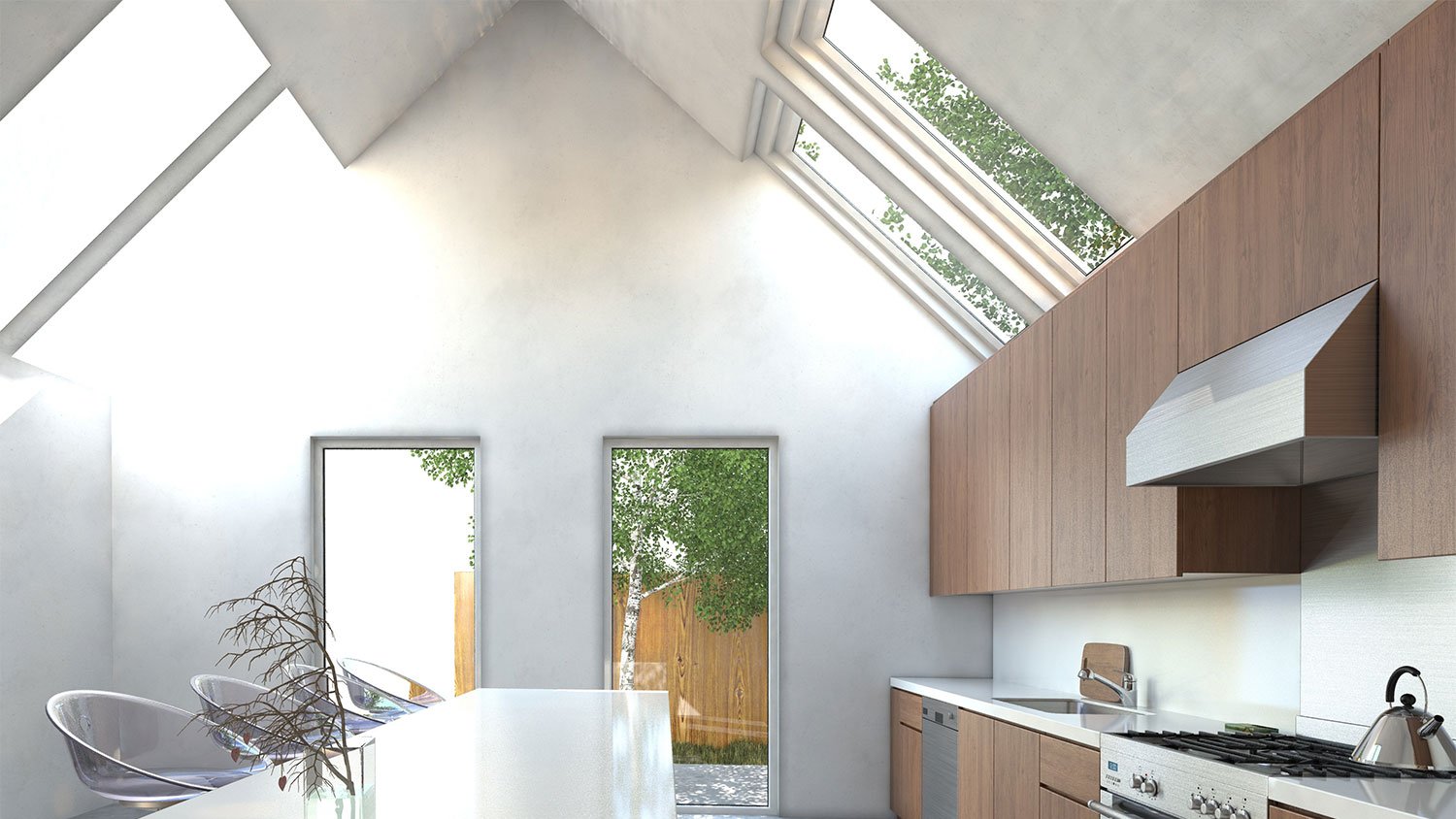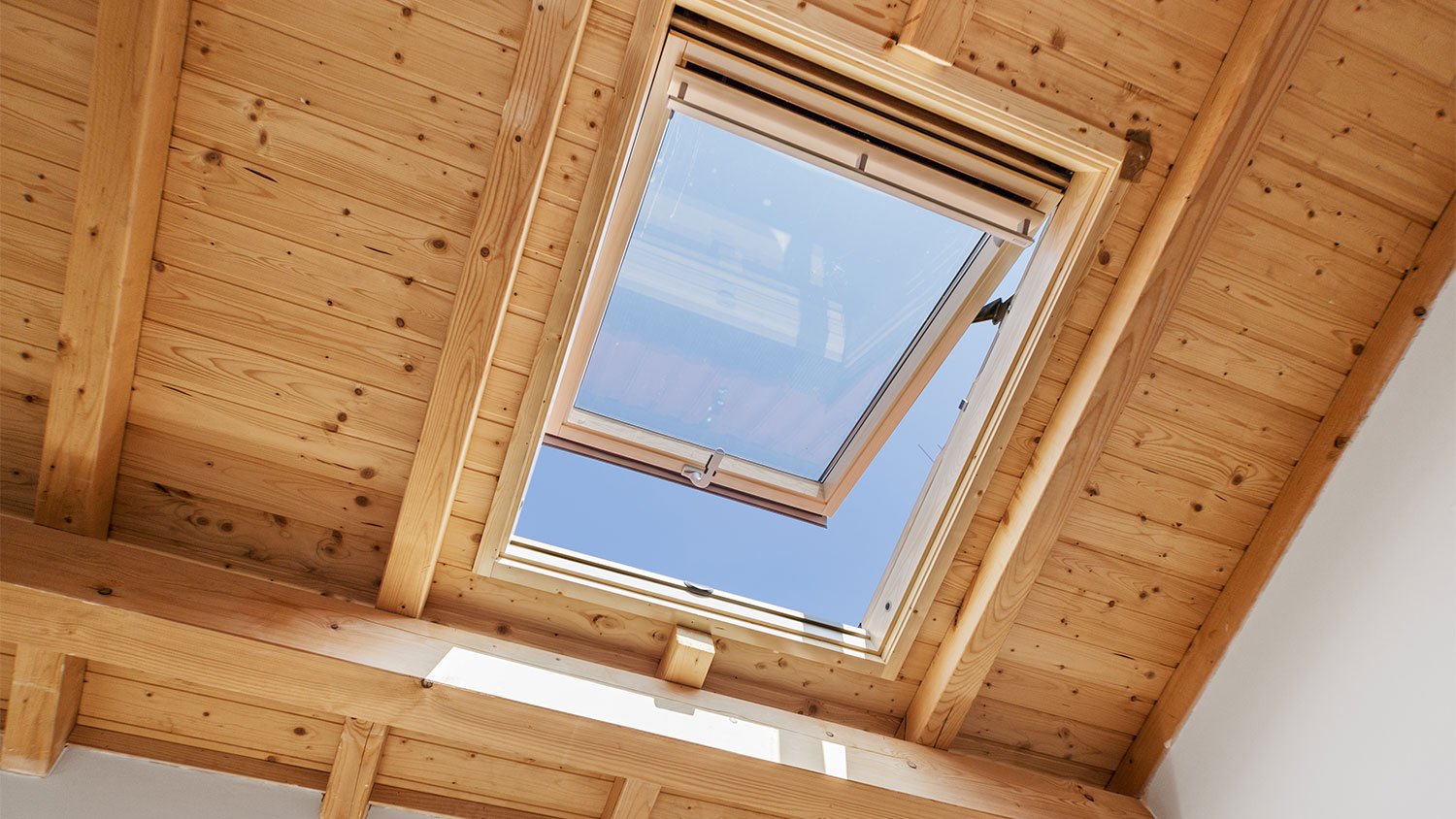What Is a Skylight? Explore Different Types, Common Problems, Costs, and More
Look up in the sky! It’s a light! No, it’s a window! Actually, it’s a skylight!


Highlights
Skylights add natural light to your home.
Common skylight types include fixed, ventilated, and tubular.
Different glazing types can protect your home from UV rays and extreme weather.
Carefully consider the location, size, and type you want to install.
It’s best to hire a professional to install skylights properly.
If you love a room filled with natural light and daydream of stargazing from your living room couch, you should consider installing skylights. So, what is a skylight, and are they worth installing? Here’s everything you need to know about skylights, including the different types, their pros and cons, costs, maintenance, common problems, and more.
What Is a Skylight?
Although there are many regular window types that add natural light to your home, skylights are unique because they’re installed on your roof. Their placement on your ceiling offers much more light than regular windows and gives any room a more airy and expansive feel. Pros can install them in many different areas of your home, whether on high, vaulted cathedral ceilings, low, sloped attic ceilings, or in small spaces like closets and hallways.
Types of Skylights
When picking the right skylight for your home, there are many different options to consider, including their size, location, and special features.
Ventilating Skylights
Ventilating skylights, also called roof windows, can open and close, hence the name. You can manually or electrically operate them, so you can install them on high ceilings with no drawbrack.
If being able to open every window in your home is a priority, then ventilated is your best bet. Also, ventilated skylights are the best option for any room in your house with high moisture, like kitchens and laundry rooms, that benefit greatly from extra ventilation.
Fixed Skylights
Fixed skylights do not open or close, so they do not provide any ventilation. These are easy to install and are best placed on high ceilings. You might opt for plastic domes for additional protection from potential moisture.
Tubular Skylights
Tubular skylights work well in small spaces like hallways and closets. With these types, sunlight travels down a light well that’s highly reflective, which then goes through a diffuser before entering your home as soft, natural light. These work well in sunny climates and don't cause as much temperature fluctuation as other skylight types.
Center-Pivot Skylights
Center-pivot skylights offer lots of fresh air because the entire window panel swings open and shut on a center pivot. This can be a good option for attics, rooms above garages, and other areas with slanted, low ceilings.
Metal-Framed Skylights
Metal-framed skylights offer a wide range of design options. These are usually made with single- or double-walled polycarbonate translucent panels and typically feature a triangular design.
Types of Skylight Glazing

Just like with a good, fresh donut, choosing the right type of glazing for your skylight is important. In fact, it can be just as important as the type of skylight you decide to use. Your preferences and the climate you live in will influence what you’ll need.
Plastic Glazing
Here are plastic glazing options to consider:
Acrylic is the most affordable choice. Acrylic glazing is most often used on domed units. If you need it, acrylic UV-blocking options are available.
Polycarbonate is a stronger material than acrylic and is more affordable than glass. It can handle extreme weather.
Glass Glazing
Here are your skylight glass glazing options:
Tempered glass is stronger than standard glass but may not be allowed by certain building codes. Why? If it breaks, it shatters into tiny pieces.
Laminated glass is stronger than tempered glass and is the same kind of glass that you would find on car windshields. It offers excellent sound insulation and UV protection.
Insulated glass has multiple layers with air space; the layers can be plastic or Polyvinyl Butyral.
Heat-strengthened glass is a more durable option than standard glass and is less likely to suffer spontaneous breakage.
Snow load glass can withstand pressure from accumulated snow.
Impact glass is rated for hurricane weather.
Colored tints are available, or you might opt for clear glass.
Silk-screened glass offers interesting designs for your skylight.
UV protection glazes help prevent sun fading on your floor and furniture and stop an unpleasant glare from happening.
Low emissivity (low-E) glass filters out UV rays and infrared radiation and prevents heat loss or gain.
Skylight Installation Considerations
Before you install a skylight, there are some important things to consider. Planning properly and ensuring you make the right choice will help you enjoy your skylight for years to come.
Location
North-facing skylights typically offer the best light without heat loss or gain. South-facing skylights lead to heat gain in the winter and heat loss in the summer. East-facing skylights offer the most light and heat gain in the mornings, while west-facing skylights lead to heat gain in the afternoons.
Size
It's crucial that you install the best-sized skylight for your space. To do this, you should measure the square footage of your room and then divide it by 20. That will give you the approximate square footage of skylights that you should consider.
Weather
If you live in an area with severe weather, like frequent hurricanes or lots of snowfall, you should opt for skylights rated for intense weather.
Building Codes
Building codes vary widely, so you should check to see if there are any specific requirements for skylights in your area. For example, some building codes require laminated glass and don’t allow tempered glass.
Mount Types
Curb-mounted skylights have a frame to which the window attaches. It can make the installation process a lot easier. Pros install flush-mounted, sometimes called deck-mounted, skylights flush with your roofline. These installations are trickier, but many people prefer the way they look.
Add-Ons
Motorized blinds can be a great addition to any skylight so that you can easily cover the windows. This helps you control the room's light and will help immensely with any potential heat loss or gain.
If you get vented skylights, consider getting one with rain sensors. These are very useful because the sensor automatically closes the window when it notices moisture.
Solar-powered skylights and shades allow you to enjoy simple, remote-controlled operations while increasing energy efficiency.
You can opt for skylights that connect to your smartphone so you can control them with an app.
Pros and Cons of Skylights

If you're not sure that you want a skylight, here are some pros and cons to consider.
Pros
Increases the natural light in the room
Makes rooms feel bigger
No sacrificing privacy
Increases ventilation
May lower your energy costs
Nice views of the sky
Cons
Heat loss and gain
Damage can be costly to repair
Poor installation could spell trouble—like leaks
Labor-intensive to install
Hard to clean
Cost of Skylights
Skylight installation costs an average of about $2,000, with a typical range between $1,000 and $3,000. Here are some average pricing estimates based on the type of skylight:
| Type of Skylight | Cost Range* |
|---|---|
| Tubular | $200 – $500 |
| Fixed | $200 – $900 |
| Ventilated | $400 – $2,000 |
*Materials only
Whether skylights are worth the price is a personal decision for you. If you want to increase natural light in a room, make a room feel bigger, and enjoy better views, then yes, a skylight is a good investment. Don’t forget to review average labor costs in your area, too, before you start budgeting for your new skylight.
Skylight Maintenance
Maintaining your skylight will help you enjoy it for a long time without issues. This should include a regular cleaning schedule of your windows and also the areas around the skylight. For example, you shouldn’t let leaves accumulate around your skylight because it can cause corrosion and damage.
If you live near the ocean, in the forest, or in areas with high levels of pollution, you should hire a local window cleaner every six months. Otherwise, you can call a pro every two years. During your regular cleaning, your cleaner may notice signs of leaks or moisture issues. In these cases, you may need to reseal the skylight.
Life Span
Your skylight should last 15 to 20 years. Yours could last a bit longer than this if you choose the most durable materials and are very diligent about cleaning and maintenance. If you notice issues with the skylight around the 15-year mark, it’s the best use of your money to replace it altogether. A skylight replacement costs $1,500 on average.
Common Skylight Problems
Like all windows, skylights aren’t without unique problems of their own. You can avoid most of these common problems with proper skylight installation and maintenance, however.
Increase in energy bills due to poorly insulated skylights
Leaks in the roof flashing due to incorrectly installed skylights or lack of re-flashing or resealing
Moisture problems from rain, snow, or condensation after poor installation
Overheated or UV-damaged skylights from lack of maintenance or using improper cleaning products
DIY vs. Hiring a Pro
Installing skylights is a project that you’re better off leaving to the pros, as it requires specific tools, precise measurements, and unique skills to do correctly. Proper installation is critical to avoid a leak and moisture-related issues. Besides the installation, it's also necessary that you choose the right type and size of skylight for your needs, and a pro can ensure your top choice is the right choice.
On top of everything else, the installation process is labor-intensive and can take a few days. It also involves going up on your roof, which is risky regardless of your experience level. Unless you have extensive prior experience with skylight installation and a firm grasp of roof safety protocols, hiring a professional skylight installer near you is the way to go.
Frequently Asked Questions
Fixed skylights are by far the most popular type. Because skylights can be pretty high up on your ceiling, fixed (rather than operable) skylights remove some maintenance from the equation. Plus, you don’t have to constantly worry if you shut your skylight fully the last time you opened it or if you’re going to find a leak later on during a rainy day.
Solar tubular lights, also referred to as tubular daylighting devices, are the most viable alternative to skylights on the market. These lights direct sunlight from the roof through a tube and into the ceiling. They also have the ability to bend around anything that may get in their way, making them adaptable to most spaces. Though they don’t offer quite as much light as a traditional skylight, they’re still an amazing alternative that can provide you with that natural light you crave.
The most popular treatment for a skylight is skylight shades. There are five primary types: manual, motorized, blackout, cellular//honeycomb, and Venetian. Motorized skylight shades are the most convenient, especially for skylights that are higher up, but manual shades are the most cost-effective treatments. Cellular/honeycomb shades are a perfect option for anyone who wants energy efficiency and an attractive look.

